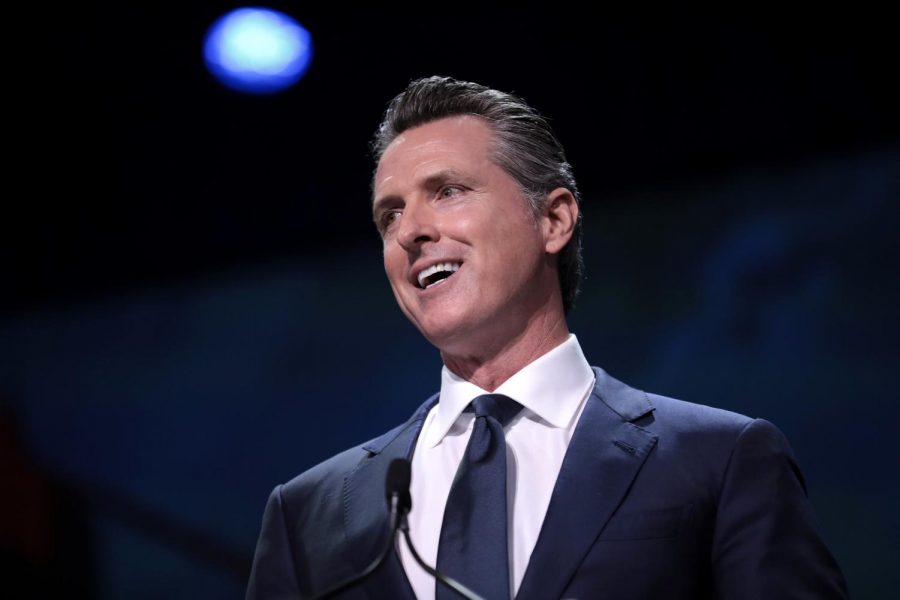Standing in the dry lakebed of Lake Mendocino, Gov. Gavin Newsom signed an executive order Wednesday to improve the state’s drought preparedness and declare a drought-caused state of emergency in Sonoma and Mendocino Counties.
“I am standing 40 feet underwater,” Newsom said, “or should be standing 40 feet underwater save for this rather historic moment.”
He was obviously not underwater, but on a podium adorned with the seal of the state of California, surrounded by dry, cracked mud. A small pond lay behind him where there should have been a lake. This was the retreating edge of Lake Mendocino.
Lake Mendocino is currently at 43% capacity. Lake Sonoma, the other major reservoir of the Russian River watershed, is at 62% capacity. Both are historic lows for this time of year.
The Russian River watershed is geographically isolated from other larger water systems in the state, and therefore, depends upon precipitation falling within its boundaries to replenish its lakes, rivers, streams and aquifers.
No more precipitation is anticipated until the fall, and water use rates are not decreasing substantially enough. This poses a dire threat for the near future of the Russian River watershed.
So as part of the executive order, Newsom signed a State of Emergency Proclamation “to address the acutely dry conditions in the Russian River watershed.” The proclamation can be seen here.
“Lake Mendocino is the canary in the coal mine when it comes to California’s drought,” said state Sen. Mike McGuire.
At the moment, only Sonoma and Mendocino counties are in a state of emergency, but the executive order allows for other counties to be added to the list as drought conditions worsen.
“We are taking a sequential approach. We are taking a targeted approach. And we are taking an approach based upon actual conditions on the ground,” Newsom said.
The governor stated that this is not a one-size-fits-all approach. Each watershed has different water circumstances and different governing bodies. Each requires a different approach.
Eighty-five percent of water management spending is done at the local level, so “local water boards play an outsized role,” Newsom explained.
The drought conditions are anticipated to be beyond the scope of “any single local government and require the combined forces of a mutual aid region or regions to appropriately respond,” the proclamation states.
The governor is calling on statewide agencies, which have greater access to resources, to partner with local governments to create regional solutions. Several press conference speakers reiterated the need for regionally tailored responses throughout the press conference, highlighting its importance to this campaign.
The charge will be led by what Newsom called “a dream team of experts, historians, as well as practitioners on all things water policy and drought.”
Some of the team members — Wade Crowfoot, secretary of California Natural Resources Agency; Karla Nemeth, director of California Department of Water Resources; and Joaquin Esquivel, chair of the California state Water Resources Control Board — spoke at the press conference.
This dream team, formed by former Gov. Jerry Brown during the previous drought, which ended in 2018, created the California Water Resilience Portfolio last year.
The portfolio, which can be seen here, laid the foundation for the action items set forth in the executive order.
The executive order legally establishes various tools and initiatives for state and local agencies to partner on in creating a drought resilient California.
One major tool will be the state Water Resources Control Board’s ability to curtail water diversions by water rights holders, and will specifically take effect in the Russian River watershed.
“That’s an important power that needs to be used judiciously,” Crowfoot said.
Another important tool, of course, is financial support. “We will be substantially increasing our financial support to address the needs of the drought,” Newsom said.
The state will draw from a state bond that was passed during the last drought, which created $7.3 billion in funding for drought preparedness.
Of that funding, $2.5 billion are already designated for seven large storage projects that will have the aggregate storage capacity of Lake Oroville, according to Newsom.
On top of the funding that already exists, the executive order also calls to accelerate funding, identify unspent funds and recommend additional financial support for water resilience infrastructure projects and actions.
One bright note of the press conference — besides the sun glaring down on the dry lakebed — was the governor noting that Californians are using 16% less water than at the beginning of the last drought and offered his gratitude for the collective effort.
Because of improved citizen conservation, the executive order does not call for water use mandates. Although, Newsom said the state could enact mandates if they become necessary.Newsom encouraged people to check out the recommendations of California’s Save Our Water campaign at www.saveourwater.com for ideas on how to further conserve water.



Anna • Oct 24, 2021 at 9:11 pm
LOVE this piece! Great writing.